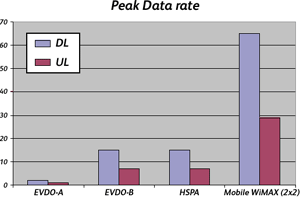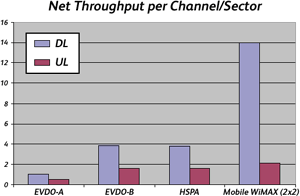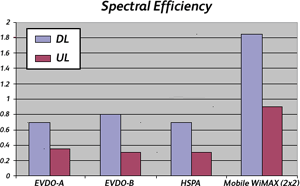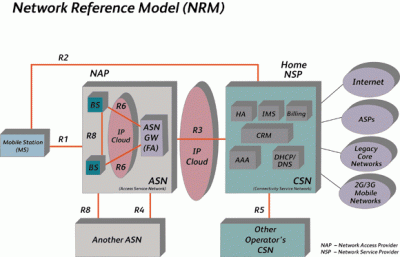Technical Overview
Mobile WiMAX – A Technical Overview
The IEEE 802.16e-2005 Mobile WiMAX standard has been developed to be the best wireless broadband standard for portable devices enabling a new era of high throughput and high delivered bandwidth together with exceptional spectral efficiency when compared to other 3G+ mobile wireless technologies such as HSPA and EV-DO.
Mobile WiMAX introduces scalable OFDMA and several other key features summarized below:
Mobile WiMAX Release 1.0 Air Interface Profile
Early in 2006 the WiMAX Forum™ selected the candidate certification profiles to cover many of the worldwide spectrum allocations suitable for Mobile WiMAX.
Mobile WiMAX Release 1 Profile certification has been divided into two stages referred to as Wave 1 and Wave 2.
Wave 1 certification addresses a single certification profile targeted at the Korean market. It excludes some fundamental features such as MIMO.True Mobile WiMAX performance will arrive through Wave 2 certification.
Wave 1 will not test for:
Airspan is focused on delivering Wave 2 compliant products, targeted at global profiles in 2.5GHz as well as the other profiles listed above.
Mobile WiMAX Performance
Using a commonly accepted evaluation methodology for 3G systems, Mobile WiMAX has been simulated against the 3G enhancements. These simulations have shown that:
The IEEE 802.16e-2005 Mobile WiMAX standard has been developed to be the best wireless broadband standard for portable devices enabling a new era of high throughput and high delivered bandwidth together with exceptional spectral efficiency when compared to other 3G+ mobile wireless technologies such as HSPA and EV-DO.
Mobile WiMAX introduces scalable OFDMA and several other key features summarized below:
- Tolerance to multipath and self interference
- Scalable channel size up to 20MHz
- TDD operation to support asymmetric traffic
- Network optimized hard handover
- Multicast and broadcast service support
- Hybrid ARQ based error control
- Power management (sleep, idle modes)
- Security and QoS
- MIMO and smart antenna technology
- Fractional frequency reuse
- Feedback based adaptive modulation
Mobile WiMAX Release 1.0 Air Interface Profile
Early in 2006 the WiMAX Forum™ selected the candidate certification profiles to cover many of the worldwide spectrum allocations suitable for Mobile WiMAX.
- Bands - 2.3-2.4GHz, 2.5-2.69GHz 3.3-3.4GHz, 3.4-3.8GHz
- Duplex method - TDD
- Channel Bandwidth - 5/7/8.75/10/20MHz
- FFT size - 512 (5MHz channel) and 1024 (10MHz channel) and 2048 (20MHz channel)
Mobile WiMAX Release 1 Profile certification has been divided into two stages referred to as Wave 1 and Wave 2.
Wave 1 certification addresses a single certification profile targeted at the Korean market. It excludes some fundamental features such as MIMO.True Mobile WiMAX performance will arrive through Wave 2 certification.
Wave 1 will not test for:
- MIMO 2x2 Matrix B
- Support for smart antennas
- Adaptive Modulation and Coding (AMC)
- IPv6 support
- Limited QoS features
- Limited Handover features
- Limited power management features
Airspan is focused on delivering Wave 2 compliant products, targeted at global profiles in 2.5GHz as well as the other profiles listed above.
Mobile WiMAX Performance
Using a commonly accepted evaluation methodology for 3G systems, Mobile WiMAX has been simulated against the 3G enhancements. These simulations have shown that:
-
Mobile WiMAX peak data rates are better than 3G and 3G+ technologies and
-
Mobile WiMAX spectral efficiency is better than any 3G and 3G+technology



Thanks to technologies such as OFDMA and MIMO, Mobile WiMAX can meet the demanding performance needs for the delivery of broadband services in a challenging mobile environment.
Performance simulations show that Mobile WiMAX provides superior throughput and spectral efficiency compared to 3G CDMA-based enhancements, EVDO and HSPA. These advantages will provide operators with added network capacity for the support of valueadded services with fewer base stations than alternative approaches, thus resulting in lower network capital and operating costs.
Mobile WiMAX Network Reference Model (NRM)
Mobile WiMAX end-to-end network architecture model follows the Network Reference Model (NRM) shown below.
Access Service Network (ASN) consists of the WiMAX Base Stations and the ASN Gateway. The main functions of the ASN gateway are to aggregate the traffic from the base stations and to manage handover between them. Airspan’s ASN Gateway solution is called ControlMAX and is described later.
Connectivity Service Network (CSN) is the core of the network. It controls and manages the ASNs and the subscribers with a variety of services such as AAA, Home Agent functions, DHCP server, etc. CSN is also responsible for connecting to other networks and enables interoperator and inter-technology roaming. Airspan’s VoiceMAX solution resides in the CSN and is described later in this document.
Airspan’s Mobile Station (MS) device, MiMAX USB, is Wave 2 compliant from the outset and supports MIMO.
Network Reference Model (NRM)





Performance simulations show that Mobile WiMAX provides superior throughput and spectral efficiency compared to 3G CDMA-based enhancements, EVDO and HSPA. These advantages will provide operators with added network capacity for the support of valueadded services with fewer base stations than alternative approaches, thus resulting in lower network capital and operating costs.
Mobile WiMAX Network Reference Model (NRM)
Mobile WiMAX end-to-end network architecture model follows the Network Reference Model (NRM) shown below.
Access Service Network (ASN) consists of the WiMAX Base Stations and the ASN Gateway. The main functions of the ASN gateway are to aggregate the traffic from the base stations and to manage handover between them. Airspan’s ASN Gateway solution is called ControlMAX and is described later.
Connectivity Service Network (CSN) is the core of the network. It controls and manages the ASNs and the subscribers with a variety of services such as AAA, Home Agent functions, DHCP server, etc. CSN is also responsible for connecting to other networks and enables interoperator and inter-technology roaming. Airspan’s VoiceMAX solution resides in the CSN and is described later in this document.
Airspan’s Mobile Station (MS) device, MiMAX USB, is Wave 2 compliant from the outset and supports MIMO.
Network Reference Model (NRM)

Mobile WiMAX Technology
To deliver the superior performance Mobile WiMAX relies on advanced technologies such as scalable OFDMA, MIMO and SAS.
MIMO stands for Multiple Input Multiple Output. It is an antenna technology that uses multiple antennas at both the transmit end and the receive end. MIMO utilizes multi-path to advantage, combining reflected signals into a single stream in order to improve throughput, reach and spectral efficiency.
Smart Antenna Systems (SAS) is an advanced antenna technology that directs the signal to the end user device. Using beamsteering/beamforming technology, SAS focuses the signal on active devices, delivering greater coverage and spectral efficiency. Airspan’s antenna technology enables the overlay of SAS on top of MIMO.
Main Features
To deliver the superior performance Mobile WiMAX relies on advanced technologies such as scalable OFDMA, MIMO and SAS.
MIMO stands for Multiple Input Multiple Output. It is an antenna technology that uses multiple antennas at both the transmit end and the receive end. MIMO utilizes multi-path to advantage, combining reflected signals into a single stream in order to improve throughput, reach and spectral efficiency.
Smart Antenna Systems (SAS) is an advanced antenna technology that directs the signal to the end user device. Using beamsteering/beamforming technology, SAS focuses the signal on active devices, delivering greater coverage and spectral efficiency. Airspan’s antenna technology enables the overlay of SAS on top of MIMO.
Main Features
- Carefully chosen set of technologies to provide superior performance
- Mobile WiMAX peak data rates are up to 5x better than 3G+ technologies
- Mobile WiMAX spectral efficiency is 3x better than any 3G+ technology
- Mobile WiMAX certification to be achieved in two stages, Wave 1 and Wave 2
- True Mobile WiMAX performance will be arrived at through Wave 2 certification
- MIMO (Matrix A & Matrix B) and SAS are essential antenna technologies to deliver the promise of WiMAX
- Option to overlay SAS on top of MIMO
- Mobile WiMAX network architecture follows NRM
- Mobile Station (MS) e.g. Airspan’s MiMAX
- Access Service Network (ASN) e.g. Control MAX and HiperMAX
- Connectivity Service Network (CSN) Industry standard solutions plus Airspan's VoiceMAX










